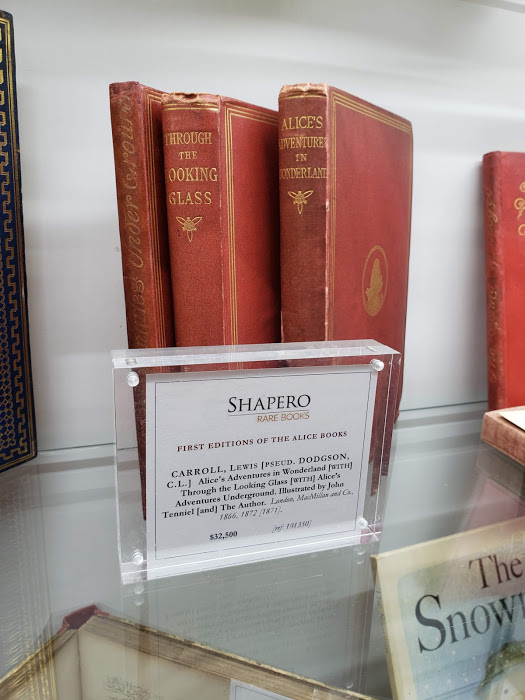
Every year, sellers from all over the world gather in New York City to show and sell rare items such as books, maps, and artwork at the New York International Antiquarian Book Fair. On March 6, 2020, I visited the Park Avenue Armory to experience this event for the first time on its 60th anniversary. The over two hundred vendors covered a wide array of niches, from music memorabilia to old medical guides, but a common item that I noticed in almost all of their booths was different variations of Lewis Carroll’s famous children’s book Alice’s Adventures in Wonderland. I chuckled when one bookseller even had what he called a “pirated American edition,” with colored illustrations and a shiny paper dust jacket, valued at around $600 and created before copyright law protected against it. However, of all the Alice books I saw, I was most pleased to be able to see the very first edition, in a trilogy set with the first edition of subsequent Alice stories.
The printing history of Alice’s Adventures in Wonderland is quite interesting. The original first edition of the novel began printing in 1865 London, but stopped its production because the illustrations were not appearing on the page adequately enough according to their artist, John Tenniel. His pencil-drawn illustrations were transferred to book pages using copper-plated lead blocks and ink in a process called electrotyping (in which a master image block is used to create a wax mold that gets coated with graphite, placed in a copper-sulfide bath, and electrically charged to form a copperplate that is durable enough for continued reuse in the printing process). There is only estimated to be about twenty copies of the book still in existence, as the rejected copies were returned to the publisher, Macmillan and Co., and recycled for other purposes.
The complete set on sale by the London-based sellers, Shapero Rare Books, is valued at $32,500. Besides some expected wear and dirtiness on the red cloth hard covers and binding, the books are in great condition. The gilt lettering, borders, and emblem all still maintain their luster. The pages are still legible and intact. It is really fascinating to be able to see such a rare piece of literary history up close, especially since Carroll had likely not intended for any of these editions to still be in circulation. I think it is a testament to the quality of the materials and the work that used to be done in the book construction process, and is worth visiting for book-lovers to truly appreciate the labor that goes into the creation of the book as a physical object.
Works Cited:






